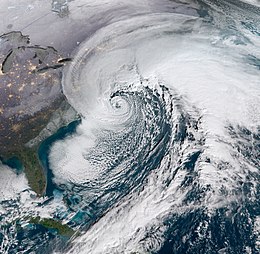 GOES-16 satellite image of the blizzard rapidly deepening off the Northeastern United States at 13:45 UTC (8:45 a.m EST) on January 4, 2018. | |
| Type | Extratropical cyclone Nor'easter Bomb cyclone Winter storm Ice storm Blizzard |
|---|---|
| Formed | January 2, 2018 |
| Dissipated | January 6, 2018 |
| Highest winds |
|
| Highest gust | 126 mph (203 km/h) in Saint-Joseph-du-Moine, Nova Scotia |
| Lowest pressure | 949 mb (28.02 inHg) |
| Maximum snowfall or ice accretion | Snowfall – 24.0 in (61 cm) in Bathurst, New Brunswick Ice – 0.5 in (1.3 cm) in Brunswick, Georgia[1] |
| Fatalities | 22 confirmed |
| Damage | $1.1 billion (2018 USD)[2] |
| Power outages | ≥ 300,000 |
| Areas affected | Cuba, The Bahamas, Bermuda, Southeastern United States, Northeastern United States, New England, Atlantic Canada |
Part of the 2017–18 North American winter | |
The January 2018 North American blizzard caused widespread severe disruption and blizzard conditions across much of the East Coasts of the United States and Canada in early January 2018. The storm dropped up to 2 feet (24 in; 61 cm) of snow in the Mid-Atlantic states, New England, and Atlantic Canada, while areas as far south as southern Georgia and far northern Florida had brief wintry precipitation, with 0.1 inches of snow measured officially in Tallahassee, Florida. The storm originated on January 3 as an area of low pressure off the coast of the Southeast. Moving swiftly to the northeast, the storm explosively deepened while moving parallel to the Eastern Seaboard, causing significant snowfall accumulations. The storm received various unofficial names, such as Winter Storm Grayson, Blizzard of 2018 and Storm Brody. The storm was also dubbed a "historic bomb cyclone".[3]
On January 3, blizzard warnings were issued for a large swath of the coast, ranging from Norfolk, Virginia all the way up to Maine. Several states, including North Carolina, New Jersey, New York, and Massachusetts declared states of emergency due to the powerful storm. Hundreds of flights were canceled ahead of the blizzard. Overall, 22 people were confirmed to have been killed due to the storm, and at least 300,000 residents in the United States lost power in total.
- ^ Cite error: The named reference
Summary6was invoked but never defined (see the help page). - ^ Benfield, Aon. "Global Catastrophe Recap - May 2018" (PDF). Aon Benfield. Archived from the original (PDF) on June 7, 2018. Retrieved June 9, 2018.
- ^ Samenow, Jason (January 4, 2018). "Historic 'bomb cyclone' unleashes blizzard conditions from coastal Virginia to New England. Frigid air to follow". Washington Post. Retrieved January 4, 2018.
© MMXXIII Rich X Search. We shall prevail. All rights reserved. Rich X Search
